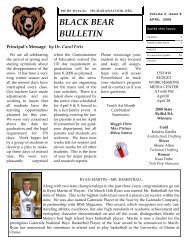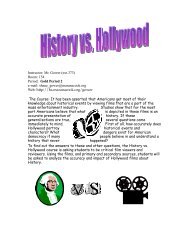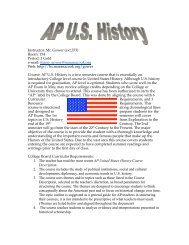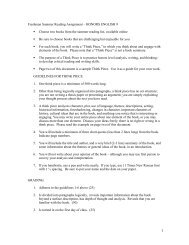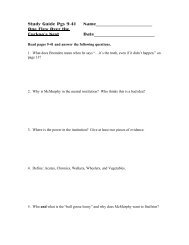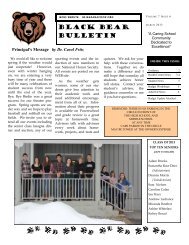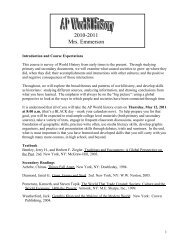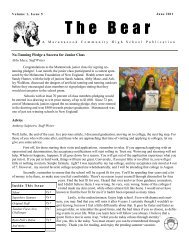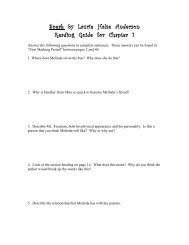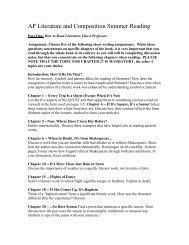AP English Language and Composition (Melcher) - Maranacook ...
AP English Language and Composition (Melcher) - Maranacook ...
AP English Language and Composition (Melcher) - Maranacook ...
Create successful ePaper yourself
Turn your PDF publications into a flip-book with our unique Google optimized e-Paper software.
<strong>Maranacook</strong> Community High School <strong>English</strong> Department<br />
<strong>AP</strong> <strong>English</strong> <strong>Language</strong> <strong>and</strong> <strong>Composition</strong> 2013-2014- Instructor: <strong>Melcher</strong><br />
Course Description:<br />
Welcome to <strong>AP</strong> <strong>Language</strong> <strong>and</strong> <strong>Composition</strong>, a course designed to be the equivalent in rigor of a college<br />
course in rhetoric, literary studies, <strong>and</strong> composition. The focus of <strong>AP</strong> <strong>Language</strong> <strong>and</strong> <strong>Composition</strong> is<br />
intensive analysis of literature – fiction, poetry, drama, <strong>and</strong> most significantly, nonfiction. This focus on<br />
nonfiction will require students to recognize, assess, <strong>and</strong> critique rhetorical, stylistic, <strong>and</strong> literary devices<br />
<strong>and</strong> strategies that can be used to enhance their own reading comprehension, academic writing, <strong>and</strong><br />
methods of argumentation. Special attention in this course will be devoted to preparing students for the<br />
<strong>AP</strong> <strong>Language</strong> <strong>and</strong> <strong>Composition</strong> examination, which tests students’ reading <strong>and</strong> writing abilities by asking<br />
them to recognize <strong>and</strong> analyze how an author shapes a piece of writing to serve the overall purpose or<br />
themes.<br />
IMPORTANT NOTE: Completion of summer reading assignments on deadline is m<strong>and</strong>atory for all<br />
<strong>AP</strong> <strong>Language</strong> <strong>and</strong> <strong>Composition</strong> students. You will not be allowed to proceed with the course if you do<br />
not submit assignments by August 19th, 2013. You may mail hard copies postmarked 8/19 or attach a<br />
document to an email, or share via Google Docs.<br />
sue_melcher@maranacook.com<br />
MCHS c/o <strong>Melcher</strong><br />
2250 Millard Harrison Drive<br />
Readfield, Me 04355<br />
Your summer reading assignment is very intensive, <strong>and</strong> should be completed in increments throughout the<br />
summer involves the following:<br />
Read The Way Out by Craig Childs<br />
In your reading <strong>and</strong> writing, you will be exploring the ways in which the narrator/author structures a text<br />
utilizing a variety of literary <strong>and</strong> rhetorical devices, as well as organization, presentation, tone, character,<br />
action, l<strong>and</strong>scape, thought, language, perception, observation, <strong>and</strong> memory to create a holistic text in<br />
which all elements are actively cooperating to create meaning, impact, <strong>and</strong> import. The structure of a<br />
text can work to create <strong>and</strong> reflect meaning that may not be explicitly evident, but is enshrouded within.<br />
You will complete the following:<br />
1. A 4-6 page essay on the assigned text<br />
2. Six close readings from the assigned text<br />
3. 20 vocabulary words<br />
4. “Room for Debate” analysis <strong>and</strong> argumentation (2 different topics)
I. ESSAY: You will write a formal, focused essay structured around ONE of the following concepts ( I<br />
have provided possible subtopics within each main area, which you may use singularly or in combination<br />
to create a thesis.) -<br />
TECHNICAL ELEMENTS OF ESSAY:<br />
a. 11 font TNR or similar font/1.5 spacing<br />
b. 4-6 pages, paginated<br />
c. MLA format<br />
d. thesis-driven<br />
e. use of quote nuggets & analysis to substantiate thesis<br />
f. submit a database of quotes taken from throughout the text, along with your own notes, to show the<br />
work behind the scenes of your essay (minimum of 20 quotes, although not all have to be used in your<br />
essay)<br />
CHOOSE FROM THE FOLLOWING TOPICS TO CRAFT A THESIS:<br />
THE ROLE OF LANDSC<strong>AP</strong>E<br />
As a storytelling device, as active “character,” as metaphor <strong>and</strong> analogy, as conveyor of character, as<br />
concealer/revealer of truths, as sensory experience, trigger of memory, a gendered aspect of the physical<br />
world, as creator of tone/mood, personification of abstract values, as place where the past is present, as a<br />
reflection of inner l<strong>and</strong>scape <strong>and</strong> values, as repository of cultural values<br />
THE ROLE AND NATURE OF STORIES/LANGUAGE<br />
Stories as structural devices for the text, use as metaphor/allegory/symbol, illustration of the relationship<br />
between l<strong>and</strong>/story <strong>and</strong> self, illustration of connection between present <strong>and</strong> past, provision of historical<br />
context, exploration of the relationship between memory, self, truth, <strong>and</strong> story; explanation of the way in<br />
which meaning is layered within story <strong>and</strong> l<strong>and</strong>scape; why stories need to be remembered/shared; the<br />
importance <strong>and</strong> nature of memory; the presence of the past within memory <strong>and</strong> l<strong>and</strong>scape, the interplay<br />
between perception, memory, <strong>and</strong> tone; the relationship between journey <strong>and</strong> stories; how l<strong>and</strong>scape itself<br />
is language <strong>and</strong> memory<br />
THE FUNCTION OF CONTRASTS<br />
Juxtaposition of Dirk/Craig; oppositional forces in nature; self vs. self; oppositional forces between people;<br />
paradoxical elements within one entity (police officer who reads poetry); urban/desert; known/unknown;<br />
tame/wild; storm/quiet; rational/irrational; fear/confidence; chaos/order; police/journalist; readable<br />
l<strong>and</strong>scape/inscrutable l<strong>and</strong>scape; desire/contentment; past/present; nature/non-natural; male/female –<br />
how these contrasts function with the story, are used as metaphors, symbols, philosophical forays, narrative<br />
devices, representation of past, ideals, ideologies…
II. CLOSE READING (See example <strong>and</strong> use a similar format)<br />
Find SIX sections throughout the text that differ from one another in tone, <strong>and</strong> do the following.<br />
a. record the page number <strong>and</strong> provide a brief context for the passage<br />
b. analyze carefully for diction, syntax, imagery, tone<br />
Diction - specific word choice - note the following:<br />
a. Words that st<strong>and</strong> out, seem perfect, add rhythm, or a specific denotation, spark up the sentence, add<br />
allure, or somehow seems to be remarkable. Foreign terms, vernacular, scientific lexicon, colloquial, or<br />
other terms of note.<br />
b. Take note of words that refer to abstract ideas in relation to words that refer to concrete elements.<br />
How does the ratio affect the passage? Is it overwhelmingly about ideas, generalizations, <strong>and</strong><br />
suggestions, or is it rooted in a world of concrete, specific things?<br />
c. Are the important words formal multisyllabic <strong>and</strong> Latinate, or simpler <strong>and</strong> more common? What is<br />
the effect?<br />
Syntax - sentence structure: take note of the following:<br />
a. Length of sentences, use of fragments<br />
b. Order of the parts of the sentence (subject, verb, object, or inverted) - do sentences begin with<br />
adjectives, adverbs, prepositional phrases?<br />
c. What are the sentences like? Are main clauses placed at the beginning, middle, or end?<br />
d. Use of punctuation - dashes, colons, semi-colons, multiple commas, questions<br />
e. How are sentences <strong>and</strong> ideas connected? Transitions, conjunctions, lack of conjunctions<br />
Imagery - appeals to the five senses: take note of the following:<br />
a. use of metaphor, simile, description, analogy<br />
b. Unusual or interesting use of words to conjure up images<br />
c. References to culture, music,<br />
d. Use of color to convey emotion<br />
e. the way language words on the subconscious to generate images<br />
Tone - author’s attitude <strong>and</strong> way of creating mood, atmosphere<br />
Use adjectives to describe tone - reverent, nostalgic, angry, jealous, objective, whimsical (there<br />
are many!)
III. “Room For Debate”<br />
The New York Times website has a feature called “Room for Debate.” (www.nytimes/roomfordebate. When<br />
you pull up this webpage, a series of discussions is displayed. Each “discussion” features five or more<br />
opinion articles. Select TWO different debate topics <strong>and</strong> do the following for each debate topic:<br />
1. Create an MLA citation (works cited entry) for each debater’s article. Use the entry information<br />
for an article from an online newswire or newspaper (see the Purdue OWL)<br />
2. Summarize each debater’s argument in 2-3 sentences.<br />
3. Analyze each argument for validity <strong>and</strong> method. How is the author supporting <strong>and</strong> substantiating the<br />
position? (opinion, facts, statistics, anecdotes, hypothetical situations, analogy, personal experience,<br />
empirical evidence). Is the argumentation valid? Explain. Is the author credible? Explain.<br />
4. Craft your own argumentation, using third person, in “letter to the editor” format, in approximately<br />
300 words.<br />
IV. VOCABULARY - context, denotation, etymological relatives, if discovered<br />
Find 20 words within any of your summer reading texts for any class or that you have read for your own<br />
amusement or enlightenment, <strong>and</strong> do the following:<br />
a. Copy out the sentence in which the word appears in your reading.<br />
b. Identify its part of speech, <strong>and</strong> any other parts of speech that word can be shaped into.<br />
c. Provide a denotation.<br />
d. Research <strong>and</strong> record its etymological roots, <strong>and</strong> record any related words that you find.<br />
e. Write your own sentence using the word literally.<br />
f. Write your own sentence using the word metaphorically.<br />
SAMPLE VOCABULARY:<br />
cloister - transitive verb - to seclude or close in, as if in a monastery,<br />
(also as a noun, a covered walk appearing in a monastery)<br />
Context: He spoke to me in the tone of a cloistered monk. (used as a participle)<br />
My sentences:<br />
I cloistered myself in my room, which was up in the stuffy attic, on the final day of summer, working steadfastly on<br />
my summer reading, an endeavor that provided me with so much fulfillment that I knew I should have begun it<br />
earlier.<br />
My thoughts cloistered themselves in the top shelves of my brain, busily multiplying <strong>and</strong> magnifying themselves in<br />
a self-aggr<strong>and</strong>izing manner, planning to burst out of hiding at some inopportune time, such as when I am plagued<br />
with insomnia.<br />
Etymology: Middle <strong>English</strong> (in the sense [place of religious seclusion] ): from Old French cloistre, from Latin<br />
claustrum, clostrum ‘lock, enclosed place,’ from claudere ‘to close.’ This word is related to “claustrophobia”
CLOSE READING EXAMPLE:<br />
Pg. 24<br />
Context: Childs is canoeing in the floodwaters of a huge storm through an inundated neighborhood - in<br />
his father’s canoe<br />
Diction: Childs lets loose a flurry of angry, energetic, volatile words that denote <strong>and</strong> connote destruction<br />
<strong>and</strong> devastation with a malevolent purpose: demolish, impaling, fists, betraying, gunfire, shotgun, revolver, drown,<br />
slammed, b<strong>and</strong>-<strong>and</strong>-clash. These jarring, harsh words explode off the page, illustrating the fiery, angry,<br />
subversive nature of his father’s personality. A few words, such as pillow, applause, neighbors, that would<br />
normally have positive connotations, are propped up here <strong>and</strong> there with anger, so as to be somewhat<br />
subverted themselves, just as Craig is now being subversive, as was his father.<br />
Syntax: “I will play loud, unbearable music. I will not sleep at appropriate hours. I will take your<br />
canoe...” - Each successive sentence begins exactly alike, enforcing the negative will of Craig <strong>and</strong> his<br />
father, their obstinacy, <strong>and</strong> their incorrigible selfishness. The “I will” in the first sentence is altered in the<br />
next two sentences by addition of the negative. The repetitive subject/verb alters with the third sentence,<br />
with a compound sentence “I will take your canoe <strong>and</strong> throw it into a flood,” which is then followed by an<br />
adjective phrase, “never to be seen again.” The repetitive syntax emphasizes the stubborn unwillingness,<br />
along with simple syntax, as if a child is speaking. Childs has reverted to childhood.<br />
Imagery: One fascinating image that creates the paradoxical nature of the father is the “bang-<strong>and</strong>-clash<br />
Mussorgsky symphony impaled (my italics) - a man who uses a gun <strong>and</strong> revolver to demolish a shed is<br />
listening to classical music, albeit loud <strong>and</strong> powerful Russian music. This paradoxical nature of people is<br />
a constant throughout Childs’ writing - for everything, there is an oppositional force continually tugging,<br />
as if there cannot be yin without yang. Additionally, use of the word impaled is disturbing: being impaled<br />
upon something is an extremely disconcerting image. The music played by a disturbed man does not float<br />
from windows, but impales the neighborhood, thus emphasizing the anger of this man, <strong>and</strong> his blatant<br />
refusal to comply with societal mores.<br />
Tone - angry, defiant<br />
GRADING<br />
1. All aspects of the assignment prompts (II, III, IV) have been adhered to (1-25)<br />
2. Work evinces sophisticated depth of thought <strong>and</strong> meaningful engagement (1-50)<br />
3. Work is well ordered, structured, edited, <strong>and</strong> evinces pride of ownership (1-25)
<strong>AP</strong> LANGUAGE & COMPOSITION – THESIS P<strong>AP</strong>ER RUBRIC<br />
Name: Date:<br />
Title:<br />
STRUCTURE – Logical format with clear introduction, thesis, analysis <strong>and</strong> conclusion,<br />
<strong>and</strong> sophisticated, fluent movement from textual evidence to analysis; strategically adept<br />
placement of quotes <strong>and</strong> examples. Introduction clearly <strong>and</strong> specifically sets up the essay<br />
<strong>and</strong> thesis, <strong>and</strong> the conclusion provides a creative clincher, closure. The structure of the<br />
piece enhances meaning <strong>and</strong> purpose. (25)<br />
INTENT/PURPOSE – The thesis is clearly <strong>and</strong> skillfully stated <strong>and</strong> supported, <strong>and</strong><br />
consistently serves as the crux of the essay; is evident in all paragraph topics <strong>and</strong> quotes.<br />
The momentum <strong>and</strong> energy of the essay is derived from the thesis. Thesis is thoughtprovoking<br />
<strong>and</strong> original. Thesis is viable <strong>and</strong> arguable, not merely a statement of fact; nor<br />
is it highly subjective <strong>and</strong> unsubstantiated. (75)<br />
EXEMPLIFICATION/DETAIL – The piece consistently uses anecdotes, examples,<br />
specifics, concrete images, details, facts, quotes (properly cited) to set up discussions <strong>and</strong><br />
analysis. Quotes are deftly woven into the prose; evocative rhetoric writing enhances <strong>and</strong><br />
clarifies the information; your prose is free from clichés, ambiguities, stale metaphors,<br />
generalized <strong>and</strong> vague language. Examples are not hypothetical or overly assumptive. You,<br />
the author, have not merely consulted the Internet, but have engaged in a meaningful <strong>and</strong><br />
compelling manner with your topic. (50)<br />
ANALYSIS/COMMENTARY – The analysis is consistently <strong>and</strong> clearly evident, beyond<br />
mere observation or statement; all analysis is equally astute <strong>and</strong> perceptive. Consistent<br />
evidence of connections, juxtapositions, parallels, argumentation, original thoughts,<br />
philosophical commentary, creative ideas. (100)<br />
PROCESS – Evidence of steady, high quality work in the form of thoughtful, meaningful<br />
changes from preliminary drafts. No errors in grammar, spelling, usage, punctuation.<br />
(only relevant for multi-draft papers) (50)



